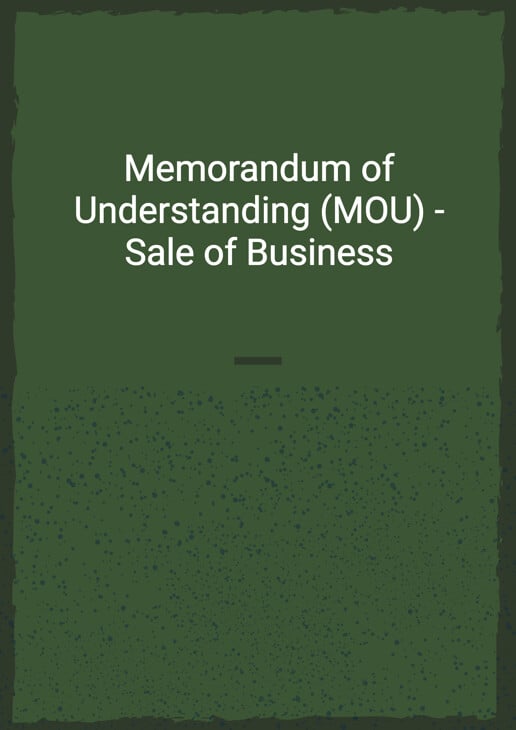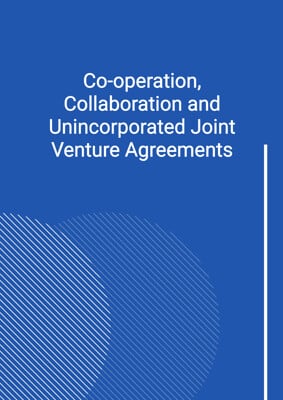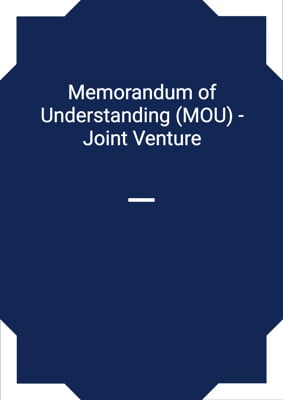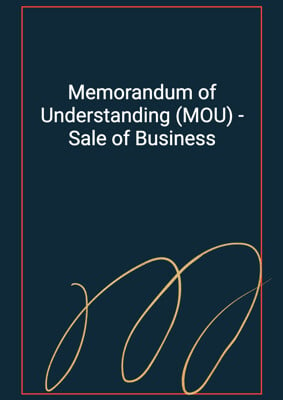How to Tailor the Document for Your Need?
01
Create Document
Fill in the details of the parties. You can click the "Fill with Member’s Information" button to complete it with information saved to your account.
02
Fill Information
Please fill in any additional information by following the step-by-step guide on the left hand side of the preview document and click the "Next" button.
03
Get Document
When you are done, click the "Get Document" button and you can download the document in Word or PDF format.
04
Review Document
Please get all parties to review the document carefully and make any final modifications to ensure that the details are correct before signing the document.
Document Preview
Document Description
The Memorandum of Understanding (MOU) - Sale of Business is a document that outlines the general terms and conditions of a proposed acquisition of a proportion% interest in a target business. The MOU is entered into between the buyer and the seller, with the aim of setting out the principles for the acquisition and guiding the parties towards successfully completing the transaction.
The document begins by highlighting the importance of the MOU in establishing the framework for the acquisition. It states that the parties will review the various arrangements in good faith and agree on the detailed terms of the acquisition based on the principles set out in the MOU. The parties will also take all necessary actions to ensure the successful completion of the transaction.
The MOU is divided into several sections, each providing a detailed introduction and explanation of its purpose. These sections include:
1. The Proposed Transaction: This section outlines the details of the proposed acquisition, including the buyer's acquisition of a proportion% interest in the target business. It specifies that the buyer will acquire all assets necessary for the conduct of the target's business activities. If applicable, it also mentions that the buyer will change the name of the target within three months following the completion of the transaction.
2. Purchase Price and Payment Terms: This section explains the aggregate consideration to be paid by the buyer for the proposed transaction, including the purchase price and the payment terms. It mentions that the purchase price comprises the goodwill and other assets of the target, subject to adjustments determined by the net asset value (NAV) of the target. It also describes the payment process, including the deposit, the signing of the sales and purchase agreement (SPA), and the payment of the remaining purchase price.
3. Transition Period: This section outlines the responsibilities and arrangements during the transition period between the signing of the MOU and the completion date or termination. It states that the seller shall cooperate with the buyer to ensure the continued operation of the target business. It also mentions that the current management of the target will remain in place during the transition period, with certain changes to the board of directors and authorized signatories of the target's bank accounts.
4. Due Diligence: This section explains the due diligence process that the buyer will undertake to assess the target business. It states that the buyer shall complete the due diligence within a specified period and that the proposed transaction is subject to the satisfactory completion of due diligence.
5. Termination: This section outlines the circumstances under which the proposed transaction may be terminated. It mentions that the transaction shall terminate if the completion is not done within a specified long stop period. It also clarifies the consequences of termination, including the refundability of the deposit.
6. Closing Conditions: This section lists the conditions that need to be fulfilled before the completion of the proposed transaction. It includes the validity of target's licenses, the continuation of target's business, the accuracy of seller's representations and warranties, and the absence of legal proceedings or investigations affecting the target's business.
7. Fees: This section explains the reimbursement of due diligence costs and expenses if the parties fail to sign the SPA within a specified period. It mentions that the reimbursement shall be deducted from the deposit and paid to the seller.
8. Third Party Approvals: This section highlights the importance of obtaining any necessary third party consents or approvals, such as consents of other partners or regulatory authorities, before completing the transaction.
9. Confidentiality and Announcements: This section establishes the confidentiality obligations of the parties and the requirement for prior written approval for any public announcements or press releases related to the transaction.
10. Dispute Resolutions: This section specifies the jurisdiction for resolving any disputes arising from the MOU.
11. Notices and Service: This section outlines the requirements for giving notices under the MOU, including the methods of service and the addresses of the parties.
12. No Rights of Third Parties: This section clarifies that the terms of the MOU cannot be enforced by any third party.
13. Legal Obligations: This section emphasizes that the MOU is not legally binding and creates no legal obligations other than those specified under confidentiality, termination, deposit, abort fee, and governing law. It states that the proposed transaction will only proceed when definitive legally binding transaction documents are agreed to and executed by the parties.
14. Taxes and Stamp Duty: This section states that each party shall bear its own taxes and 50% of the stamp duty for the proposed transaction.
In conclusion, the Memorandum of Understanding (MOU) - Sale of Business is a crucial document that outlines the general terms and conditions of a proposed acquisition. It provides a detailed introduction and explanation of each section, ensuring that both parties are fully informed and understand the implications of the transaction.
How to use this document?
1. Review the Proposed Transaction: Carefully review the details of the proposed acquisition, including the buyer's acquisition of a proportion% interest in the target business. Take note of any specific requirements or conditions mentioned in this section.
2. Understand the Purchase Price and Payment Terms: Familiarize yourself with the aggregate consideration to be paid by the buyer, including the purchase price and the payment terms. Pay attention to any adjustments based on the net asset value (NAV) of the target and the process for deposit, signing the sales and purchase agreement (SPA), and payment of the remaining purchase price.
3. Prepare for the Transition Period: Be aware of the responsibilities and arrangements during the transition period between the signing of the MOU and the completion date or termination. Ensure that the current management of the target remains in place and that any necessary changes to the board of directors and authorized signatories of the target's bank accounts are made.
4. Conduct Due Diligence: Follow the due diligence process outlined in the MOU to assess the target business. Complete the due diligence within the specified period and ensure that the proposed transaction is subject to satisfactory due diligence results.
5. Understand Termination Conditions: Familiarize yourself with the circumstances under which the proposed transaction may be terminated. Take note of the consequences of termination, including the refundability of the deposit.
6. Fulfill Closing Conditions: Ensure that all the closing conditions listed in the MOU are met before proceeding with the completion of the proposed transaction. Obtain any necessary third party consents or approvals and comply with the requirements regarding licenses, business continuation, representations and warranties, and absence of legal proceedings or investigations.
7. Reimburse Due Diligence Costs: If the parties fail to sign the SPA within the specified period, be prepared to reimburse reasonable due diligence costs and expenses incurred by the seller. Understand that these costs will be deducted from the deposit.
8. Maintain Confidentiality: Adhere to the confidentiality obligations stated in the MOU. Do not disclose any information obtained from the other party except for the purposes of the acquisition. Seek prior written approval for any public announcements or press releases related to the transaction.
9. Resolve Disputes: Understand the jurisdiction for resolving any disputes arising from the MOU. Be prepared to follow the specified dispute resolution process if necessary.
10. Follow Notice and Service Requirements: Comply with the requirements for giving notices under the MOU. Use the specified methods of service and ensure that the addresses of the parties are accurate.
11. Seek Legal Advice: Although the MOU is not legally binding, consider seeking legal advice when proceeding with the proposed transaction. Consult with professionals to ensure that all legal obligations and requirements are met.
12. Manage Taxes and Stamp Duty: Understand your tax obligations and be prepared to bear your own taxes and 50% of the stamp duty for the proposed transaction.
Note: This guidance provides a general overview of the steps to follow when using the MOU. It is important to refer to the specific details and provisions in the document for a comprehensive understanding of the transaction and its implications.
Not the right document?
Don’t worry, we have thousands of documents for you to choose from:

























